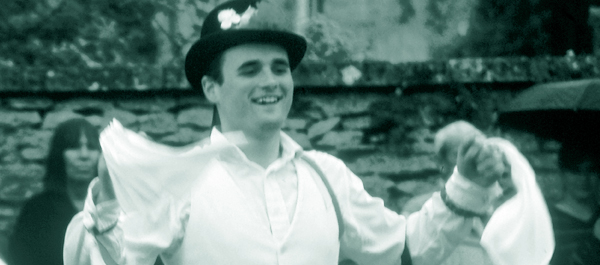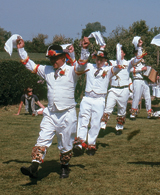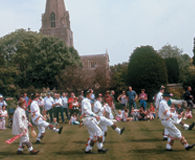
Morris dancers from different towns wear distinctive costumes and dance to slightly different steps.
Three things say a man is in England, four things make his location sure: cream teas, roundabouts, pay and display—and morris dancing on Spring bank holiday.
I had barely finished my full English breakfast, when I heard a fiddle launch into “Constant Billy.” Wheelgate House B&B, in Bampton’s ancient marketplace and town center, was ideally situated to observe the first morris dancers of Spring bank holiday.
Sixteen miles southwest of Oxford, Bampton is a village of fewer than 2,000 souls. It is, nevertheless, a center for morris dancing in England. Written records indicate morris dancing has been popular in the town since the late 18th century, and tradition says dancers have performed there on Whit Monday as far back as the 16th century. On May Bank Holiday, three teams, or “sides,” would dance throughout the village, and be joined in late afternoon by visiting sides from Eynsham and Abingdon.
 As with many English traditions—and morris dancing is English, not British; the Scots never took it up—no one knows when or why morris dancing began. Some claim it to be an ancient druid fertility rite, but these are the same folk who claim any English custom or relic from the distant past to be druidic in origin.
As with many English traditions—and morris dancing is English, not British; the Scots never took it up—no one knows when or why morris dancing began. Some claim it to be an ancient druid fertility rite, but these are the same folk who claim any English custom or relic from the distant past to be druidic in origin.
The earliest English mention of “morys” dancing comes in the late 15th century, in a court setting, with both men and women participating. Shakespeare mentioned morris dancing in several works, and his actor-friend Will Kempe was a “morrice dauncer.” Some sources claim that the term was originally “Moorish” dancing, and came to England from the Iberian Peninsula. Morris dancing’s origins may be in doubt; the fun is not.
Morris dancers from different towns wear distinctive costumes and dance to slightly different steps, but some aspects of the dance and dancers are similar. Traditionally, only men are morris dancers. But, as with other sacred traditions, this custom is breaking down. There are scattered about England a few female sides, and a handful of mixed teams.
Dancers wear white shirts and trousers, and decorate sleeves, trousers and hats with ribbons and flowers, according to local custom. Circlets of bells go around the legs, just below the knee. Hats of silk or beaver complete the costume. Most dances are performed by a group of six to 10, but there also are dances done by one or two participants only. The pipe dance, where clay pipes are laid in an “X” before the musician, and the dancer capers about them, is such a dance.
 One member of each side is identified as the clown, and his garb will differ from the others. Sometimes called the “squire,” he carries a staff with an inflated pig’s bladder attached to one end, and a calf’s tail fixed to the other. With this tool he “belabors the bystanders,” and occasionally delivers a swat across the rump of a dancer with the pig bladder to encourage greater exertion.
One member of each side is identified as the clown, and his garb will differ from the others. Sometimes called the “squire,” he carries a staff with an inflated pig’s bladder attached to one end, and a calf’s tail fixed to the other. With this tool he “belabors the bystanders,” and occasionally delivers a swat across the rump of a dancer with the pig bladder to encourage greater exertion.
Another participant is the sword-bearer. This fellow carries a cake, in a round tin, impaled on a vertical sword. Both sword and cake are decorated with ribbons and flowers. A portion of the cake is given to any bystander who contributes to the “squire’s treasury.” Possessing a fragment of cake is said to bring good luck for the coming year, and for the female buyer, fertility.
Centuries ago dancers cavorted to tunes from “whittle and dub”—pipe and tabor. Today they prance to the music of fiddles and concertinas. On this spring morning, one Bampton side honored Reg Hall, who had played the fiddle for that side for 50 years.
[continued on next page]
